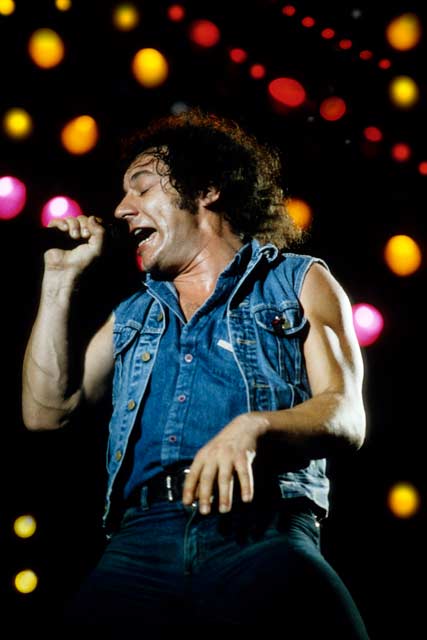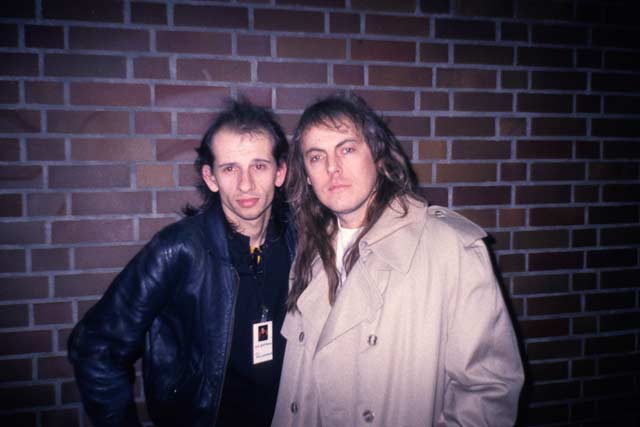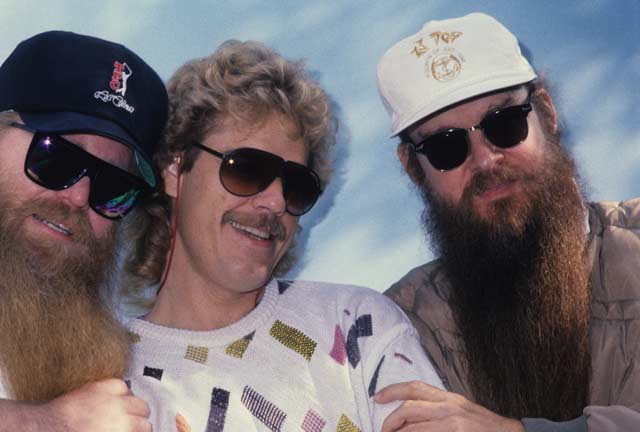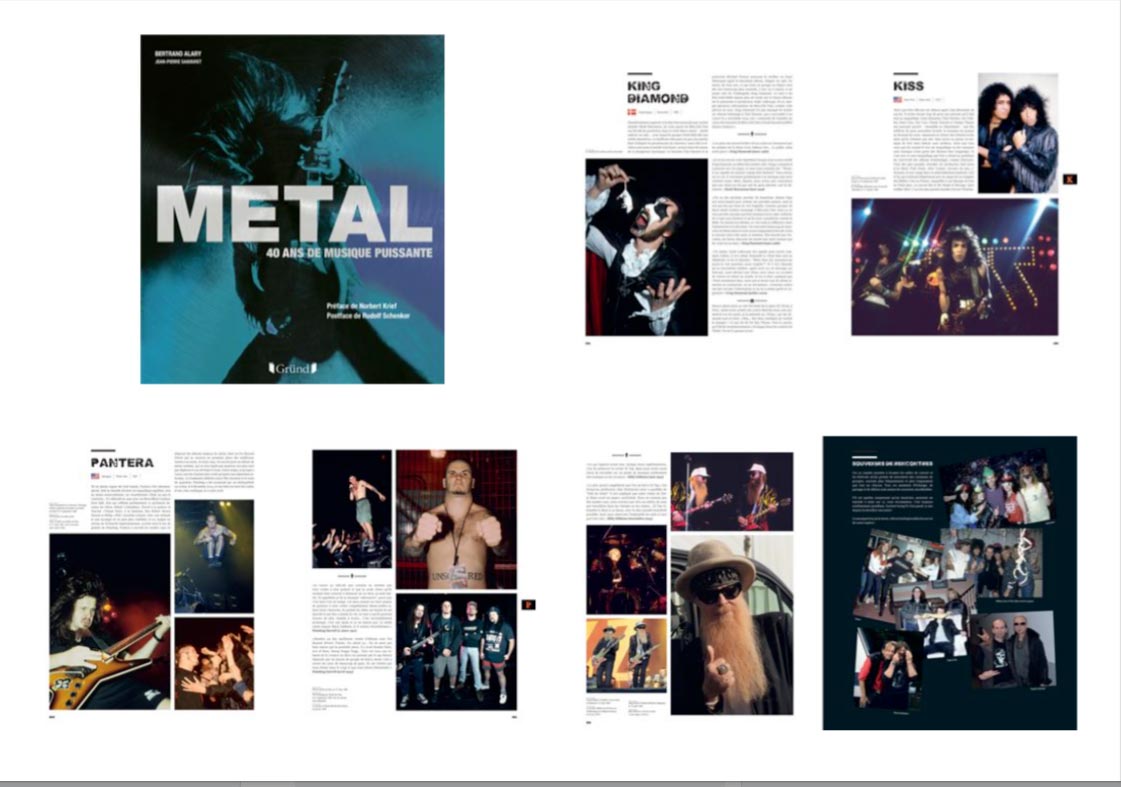
Bertrand Alary has been a published Rock and Metal photographer since 1983. Having worked with magazines including Kerrang, Metal Hammer, RAW, Burn, Metallix and Metal Maniacs to name just six, Alary’s images have been burnt into the eyes of millions of music fans across the entire globe.
Interview: Steve Ritchie.
As a photographer, Bertrand Alary is up there with the best. Having shot his first gig in the early 80’s, his first print published work came in 1983. As Bertrand worked to develop his style over the years, increasing levels of access to the bands and performers came, resulting in some of the best iconic images.
Rudolf Schenker photographed clothed and in a swimming pool?
Yep, that was one of Bertrand’s photos and it is a fascinating example of how artists trusted him to produce quality unique images. It also shows how Bertrand learnt to push the boundaries of what can be achieved.
With COVID-19 dragging the live music industry to a grinding halt, Bertrand has used this time to sift through his massive archive of images and he has produced what can only be described as ‘The Metal Bible’. And as a photographer, the chance to speak with Bertrand about his fabulous career was not one for me to pass on.
 AC/DC. Photo Bertrand Alary
AC/DC. Photo Bertrand Alary
With 666 photos spread over 328 pages, the impressive ‘Metal: 40 Years Of Loud Music’ book is an encyclopaedia of the Metal years.
It covers 400 bands, listed from A-Z and includes notes and interviews written by long term collaborator Jean-Pierre Sabouret.
From Asia to Zakk Sabbath, Tysondog to Heavy Pettin’, ZZ Top to Lee Aaron, this is a comprehensive collection of the Metal Years all backed with Alary’s great photography.
The really difficult job is how to cover something as impressive and huge as this.
The Mötley Crüe section is impressive, featuring images from their ’84 Donington appearance including some fantastic backstage shots. Saxon, from ’85, is a delightful capture of a moment of history, while the Scorpions section is especially stunning.
Metallica, with Cliff Burton, Guns N’ Roses with a babyfaced Axl, Van Halen (RIP Eddie) and a youthful looking Roth are other standouts.
Wendy O Williams is there in a memorable pose, just below Blaze Bayley from his earlier Wolfsbane days.
At the end of the day, anyone who can ask Steve Vai to lay on a train track for a photo shoot is more than worth reading about and at 27cm x 31cm this book is the perfect recipe for passing away these COVID-19 lockdown times.
 Bertrand Alary with Don Dokken
Bertrand Alary with Don Dokken
Can you tell us how you first got into photography and why music photography was your inspiration?
“I always liked photography and listened to music from the age of 11. Bands like Slade, Sweet and Kiss.
“My father taught me a bit, then I taught myself. My first ever gig was KISS on 27 September 1980 in Paris. I spoke with one of the official photographers there, who told me it was his job. I decided to do the same and three years later, my first photo was published!”
Can you talk about the first important article with band photos which you had published?
“In 1983 there was a new magazine out called Enfer. I bought a copy of the first issue and in France this was the first Hard Rock/Heavy Metal magazine. I used the contact details in the magazine, met with them and using my portfolio of three years of photography their hired me.
“My first photos were in issue No.2.
“I approached Metal Attack in 1984, Hard Rock in 1985 the same way.
“I then got to work with Hard Force and Hard & Heavy, which were also French magazines.
“This led to working with Kerrang and RAW in the UK, Burn in Japan, Metal Hammer in Germany, Aardschok in The Netherlands and then Metallix and Metal Maniacs in the USA.”
In the late 80’s, you would have been shooting film. Can you talk about your camera setup? Did you develop the film yourself? Did you use fast film, or rely on the post-process to get the right results?
“In the beginning, the technical aspects were less important for me. It was more important to be at the right place at the right time. I tried to get backstage access and make unique images. That is why I always brought backdrops with me. Backstage I could capture unique images and was not photographing with others.
“I spent a lot of money with photo labs. I always shot colour film.
“I also bought a small camera where, especially at festivals, I would take a few shots and see film. I used these myself, along with the music. to make a film trailer for the book. The music is from a friend of mine’s band called Traffic Jam.”
How was the three song rule in those days? Was it as big a problem as today? Was it enforced?
“The three song rule did not exist at all in the beginning. When you had a photo pass you could shoot all through the show.
“When it begin to be restricted to three songs, this was not creative. Now to be able to do more than three songs, you need to be friend of the manager or the artists themselves.”
You got a great shot of the Dio dragon – I saw that tour and the Dragon part was not in the first three songs…… How did you manage that?
“I become friends with Ronnie himself, after meeting him more than 20 times. He allowed me more songs and I even managed to get some Access All Areas passes.
“I had similar situations with Motörhead and Lemmy, The Scorpions with Rudolf, Bon Jovi with Jon, Iron Maiden with Bruce and Ozzy.”
 ZZ Top. Photo Bertrand Alary
ZZ Top. Photo Bertrand Alary
You photographed all the guitar greats… Vai, EVH, Schenker, Fast Eddie, Gary Moore….. can you remember your favourite?
“Eddie was certainly the most astonishing one. He invented a new way to play guitar. When I first saw on him on stage I thought “Wow! How can he do that?”
“Gary Moore was difficult to photograph. He did not like his face, so he always tried to escape. Even when a session was approved and planned.
“Plenty of others in the book, such as Jenifer Batten, Steve Vai (who I laid on a railway in Cannes in 1993), Joe Satriani or Yngwie Malmsteen are all superstars.”
When did you have the idea for the book? Is this something you have had in the back of your mind from the early days?
“I always had it at the back of my mind, but never had time to scan and edit. The photo choices and the legends was a long process. Every photo has an exact date and location where the photo was taken. This was a big process.
“I had everything in a separate box, which contained what I thought was the best shot of the day. I have done that for forty years.
“Now with the first lockdown, it was so much easier. After finding a publisher who wanted to release the book, I sat down and told myself “Lets do this.”
“It took me at least three full months!”
The words of Jean-Pierre add a really nice element to the book. Can you remember when you first met?
“I’ve known him for more than 35 years. He was Chief Editor at Hard Rock magazine, where I had many photos published between ’84 and ’93.
“So we know each other perfectly. He has written text for other books, such as a biography on Motörhead/Lemmy.
“I asked Jean Pierre to write for the book and he said yes, almost immediately.”
When did you move digital? How was that for you? Did you adopt early, or later?
“Around the beginning of 2000, when it first became available.
“The biggest advantage is you do not ‘loan’ your original slides anymore to publications, so you don’t lose a few anymore.
“The bad things is that after buying the camera, although you have no costs anymore in buying films and developing), you take many more photographs, so you spend a huge time just editing for the final choices, after all. At a festival you might bring back 10,000 images and need just to keep less than 500. This is a big task.
As you progressed, you got greater access. Your promotional shots are great. Can you remember your first big “wow” moment?
“Putting Rudolf Schenker from the Scorpions underwater in a pool back in 1989 was a fantastic moment. He agreed immediately on the idea.
“It was difficult to organise, but we succeeded. I found a pool with an underwater window. The main difficulty was he see me, so I was knocking on the window so he knew where to go. That was so funny. But the result was amazing!
“Shooting from the stage during Sepultura at the Maracana stadium in Rio de Janeiro in January 1991 was also a great time. The audience was so huge and so crazy there!
“It was so hot that day, that the fire marshalls had to send water over the crowd with a fire hose to calm everything down.
 Bertrand Alary. Metal – 40 Years Of Loud Music.
Bertrand Alary. Metal – 40 Years Of Loud Music.
How do you see music photography these days? With iPhones and the web, it seems anyone can jump on the bandwagon. How do you see the future panning out?
“The current situation is more complex. Yes everyone can make photos with their mobile phone and the quality sometime is now not so bad.
“But I’ve no real idea for the future. It’s more complicated now with the press. Many titles are closing now, especially with the internet.
“I’m not quite sure you can still earn a living, unless you are staff on magazine.
“I was always freelance, dealing with several publications at the same time.”
Who is your favourite band/musician you have shot? Can you give me a story behind that……
“I would say Kiss. They are the most professional band I have ever met. At the beginning of the show, during the three songs, each band member look at every photographer one by one, to make sure you have a nice photo!
“No one else does that. Except maybe Rudolf pointing when he recognises someone!
“Rudolf is great – he also immediately agreed to write some words for the book when I asked him.”
You shot Donington, in the UK, back when it was a different festival to today. How was that?
“The difference is that only 15 to 20 photographers were allowed in. So it was difficult to be included in the pool. Many thanks to Judy Totton!
“At that time, there was only one stage. So with six bands in a full day, you were having plenty of time to go into the crowd, to take funny photos of the audience and to capture the atmosphere.
“Now, for example at Hellfest in France, there are six stages and 300 bands over three days. This leaves no time to rest. It is not possible to shoot everything alone. And there are 250 photographers there!
“Apart from this year as it has been cancelled like every concert all around the world since March, because of COVID-19.”
Icons of Metal. That is how I would describe your book and you were there to capture it all. It was a special time in Metal history. How do you feel, looking back, at those times now?
“Many times in the book I write about those special moments which happen. Ozzy having a piss in an elevator, Mötley Crüe with my wife modelling. Lemmy as Father Christmas, a funny Bruce Dickinson portrait. Girlschool dressed as nuns! But there are so many more.
“I remember how complicated it was to bring Rudolf Schenker (yes him again!!) to the top the the Hellfest big wheel in 2015.
“I sent him an email showing how would it look and he said meet me at 8PM on the day there!
“He asked for two Mercedes to be ready and we went to the technical access, got in the wheel and they stopped it at very top for three or four minutes until the sun went down.
“The result was astonishing. The crowds recognised him, of course, especially because his Flying V. They were shouting his name throughout the session.”
We love the book. It is maybe the greatest Metal encyclopaedia out there. Very well done. It is great to sit and work through over a coffee or glass of wine. Are you happy how it came out? Any plans for translated versions?
“It is the first time I believe for an illustrated ‘A to Z’ book, especially talking about so many different bands. Usually you only see 30 or 40 only the biggest names.
“I have tried to put all of those that I have met during my long career.
“I hope the translation will happen. The French editor is trying to get licenses as we speak.
“I also hope the readers will enjoy it. I have tried to share the time I have spent and the chances I had to meet so many great bands and iconic people.”

Metal: 40 Years of Loud Music is published by Gründ and is available from all good booksellers.
For more information see http://www.bertrandalary.fr
The post
Bertrand Alary / 40 Mammoth Years Photographing Heavy Metal first appeared on
MetalTalk - Heavy Metal News, Reviews and Interviews.